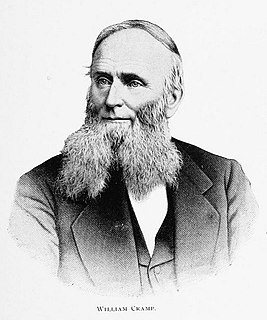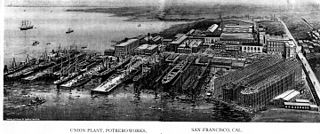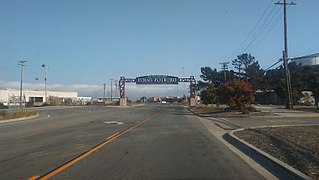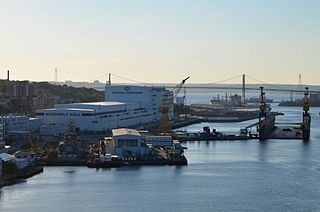
Newport News Shipbuilding (NNS), a division of Huntington Ingalls Industries, is the largest industrial employer in Virginia, and sole designer, builder and refueler of United States Navy aircraft carriers and one of two providers of U.S. Navy submarines. Founded as the Chesapeake Dry Dock and Construction Co. in 1886, Newport News Shipbuilding has built more than 800 ships, including both naval and commercial ships. Located in the city of Newport News, their facilities span more than 550 acres (2.2 km2), strategically positioned in one of the great harbors of the East Coast.

William Cramp & Sons Shipbuilding Company of Philadelphia was founded in 1830 by William Cramp, and was the preeminent U.S. iron shipbuilder of the late 19th century. In 1890 the company built the battleships USS Indiana and USS Massachusetts, armored cruiser USS New York, and protected cruiser USS Columbia. Three of these ships took a part in the battle with the Spanish fleet in 1898 at Santiago de Cuba. The victory in this battle heralded America's emergence as a great power. The American Shipping and Commercial Corporation bought the yard in 1919 but closed it in 1927 as fewer ships were ordered by the U.S. Navy after passage of the Naval Limitations Treaty in 1923.

Vigor Shipyards was founded in 1916 as the William H. Todd Corporation through the merger of Robins Dry Dock & Repair Company of Erie Basin, Brooklyn, New York, the Tietjen & Long Dry Dock Company of Hoboken, New Jersey, and the Seattle Construction and Dry Dock Company. The Seattle shipyard could trace its history back to 1882, when Robert Moran opened a marine repair shop at Yesler's Wharf. This shop became the Moran Brothers Shipyard in 1906 and the Seattle Construction & Dry Dock Company at the end of 1911.

Union Iron Works, located in San Francisco, California, on the southeast waterfront, was a central business within the large industrial zone of Potrero Point, for four decades at the end of the nineteenth and beginning of the twentieth centuries.

CSSRichmond, an ironclad ram, was built for use in the American Civil War at Gosport (Norfolk) Navy Yard to the design of John L. Porter with money and scrap iron collected by the citizens of Virginia, whose imagination had been captured by the ironclad CSS Virginia. Consequently, she was sometimes referred to as Virginia II, Virginia No. 2 or Young Virginia in the South and as Merrimack No. 2, New Merrimack or Young Merrimack by Union writers, months before the actual CSS Virginia II was ever laid down.
Tobacco Row is a collection of tobacco warehouses and cigarette factories in Richmond, Virginia adjacent to the James River and Kanawha Canal near its eastern terminus at the head of navigation of the James River.

The Altria Theater in Richmond, Virginia, United States is a theater at the southwest corner of Monroe Park, the largest venue of Richmond CenterStage's performing arts complex. Formerly known as The Mosque and the Landmark Theater, the Altria Theater was originally built for Shriners of the Acca Temple Shrine.

The Scottish Maritime Museum is an industrial museum with a collection recognised as Nationally Significant to Scotland. It is located at two sites in the West of Scotland in Irvine and Dumbarton, with a focus on Scotland's shipbuilding heritage.

The Kaiser Shipyards were seven major shipbuilding yards located on the United States west coast during World War II. Kaiser ranked 20th among U.S. corporations in the value of wartime production contracts. The shipyards were owned by the Kaiser Shipbuilding Company, a creation of American industrialist Henry J. Kaiser (1882–1967), who established the shipbuilding company around 1939 in order to help meet the construction goals set by the United States Maritime Commission for merchant shipping.

William Doxford & Sons Ltd, often referred to simply as Doxford, was a British shipbuilding and marine engineering company.
Moore Dry Dock Company was a ship repair and shipbuilding company in Oakland, California.

The Halifax Shipyard Limited is a Canadian shipbuilding company located in Halifax, Nova Scotia.
Birely, Hillman & Streaker was a prominent Philadelphia shipbuilding firm through the latter part of the 19th century. The shipyard specialized in the manufacturer of large wooden paddle steamers and wooden steamboats for the domestic American market.

USRC Mohawk, was a steel steam powered revenue cutter built for the U.S. Revenue Cutter Service by William R. Trigg Company at Richmond, Virginia. Her primary duties in the Revenue Cutter Service and Coast Guard were assisting vessels in distress and enforcing navigational laws as well as a derelict destroyer. Mohawk was sunk after a collision with another vessel in October 1917.

Winslow Marine Railway and Shipbuilding Company was a shipyard that operated from 1903 until 1959 on Bainbridge Island, Washington, United States.
















